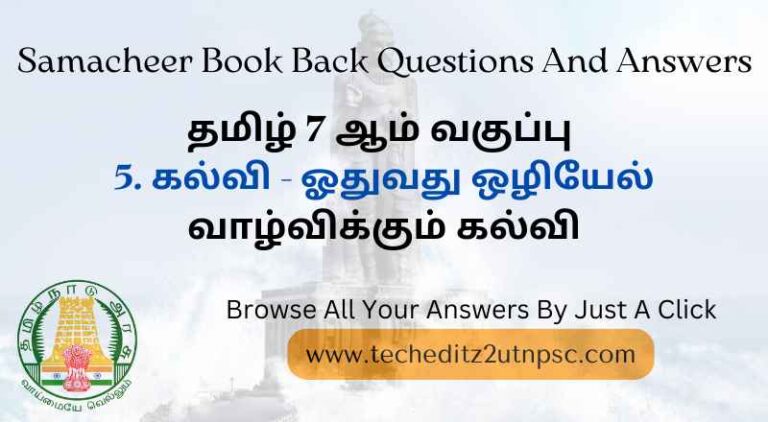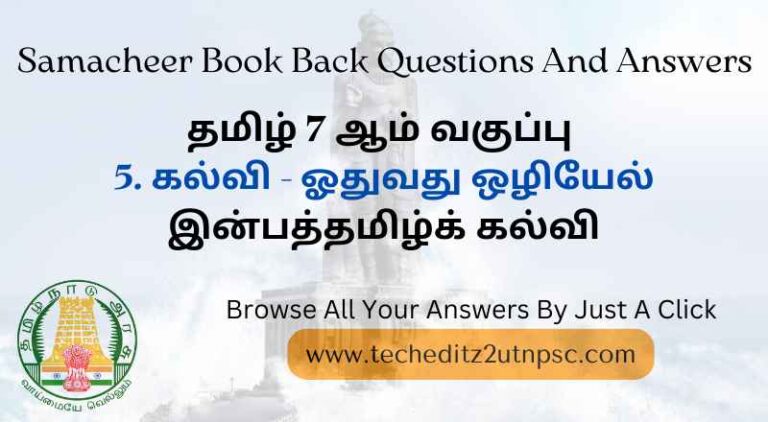support@techeditz2utnpsc.com | 8300-921-521

Nuclear Physics
Samacheer Book Back Questions And Answers For Science Standard 10 “Nuclear Physics“
I. Choose the correct answer:
1. Man-made radioactivity is also known as _____.
a. Induced radioactivity
b. Spontaneous radioactivity
c. Artificial radioactivity
d. a & c
2. Unit of radioactivity is _____.
a. roentgen
b. curie
c. becquerel
d. all the above
3. Artificial radioactivity was discovered by _____.
a. Bequerel
b. Irene Curie
c. Roentgen
d. Neils Bohr
4. In which of the following, no change in mass number of the daughter nuclei takes place
i) α decay
ii) β decay
iii) γ decay
iv) neutron decay
a. (i) is correct
b. (ii) and (iii) are correct
c. (i) & ( iv) are correct
d. (i) & (iv) are correct
5. _____ isotope is used for the treatment of cancer.
a. Radio Iodine
b. Radio Cobalt
c. Radio Carbon
d. Radio Nickel
6. Gamma radiations are dangerous because
a. it affects eyes & bones
b. it affects tissues
c. it produces genetic disorder
d. it produces enormous amount of heat
7. _____ aprons are used to protect us from gamma radiations
a. Lead oxide
b. Iron
c. Lead
d. Aluminium
8. Which of the following statements is/are correct?
i. α particles are photons
ii. Penetrating power of γ radiation is very low
iii. Ionization power is maximum for α rays
iv. Penetrating power of γ radiation is very high
a. (i) & (ii) are correct
b. (ii) & (iii) are correct
c. (iv) only correct
d. (iii) & (iv) are correct
9. Proton – Proton chain reaction is an example of _____.
a. Nuclear fission
b. α – decay
c. Nuclear fusion
d. β – decay
10. In the nuclear reaction, the value of A & Z.
a. 8, 6
b. 8, 4
c. 4, 8
d. cannot be determined with the given data
11. Kamini reactor is located at _____.
a. Kalpakkam
b. Koodankulam
c. Mumbai
d. Rajasthan
12. Which of the following is/are correct?
i. Chain reaction takes place in a nuclear reactor and an atomic bomb.
ii. The chain reaction in a nuclear reactor is controlled
iii. The chain reaction in a nuclear reactor is not controlled
iv. No chain reaction takes place in an atom bomb
a. (i) only correct
b. (i) & (ii) are correct
c. (iv) only correct
d. (iii) & (iv) are correct
II. Fill in the blanks:
1. One roentgen is equal to _____ disintegrations per second
2. Positron is an _____.
3. Anemia can be cured by _____ isotope
4. Abbreviation of ICRP _____.
5. _____ is used to measure exposure rate of radiation in humans.
6. _____ has the greatest penetration power.
7. ZYA → Z+1YA + X ; Then, X is _____.
8. ZXA → ZYA This reaction is possible in _____ decay.
9. The average energy released in each fusion reaction is about _____ J.
10. Nuclear fusion is possible only at an extremely high temperature of the order of _____ K.
11. The radio isotope of _____ helps to increase the productivity of crops.
12. If the radiation exposure is 100 R, it may cause _____.
Answers:
1. 3.7 x 1010
2. antiparticle of electron
3. Radio iron
4. International Commission on Radiological Protection
5. Dosimeter
6. Gamma rays
7. Beta particle
8. Gamma
9. 3.84×1012
10. 107 to 109
11. phosphorous
12. leukemia
III. State whether the following statements are true or false: If false, correct the statement:
1. Plutonium -239 is a fissionable material.
2. Elements having atomic number greater than 83 can undergo nuclear fusion.
3. Nuclear fusion is more dangerous than nuclear fission.
4. Natural uranium U-238 is the core fuel used in a nuclear reactor.
5. If a moderator is not present, then a nuclear reactor will behave as an atom bomb.
6. During one nuclear fission on an average, 2 to 3 neutrons are produced.
7. Einstein’s theory of mass energy equivalence is used in nuclear fission and fusion.
Answers:
1. True
2. False (Elements having atomic number greater than 83 can undergo nuclear fission)
3. True
4. False (Natural uranium U-235 is the core fuel used in a nuclear reactor)
5. False (If a moderator is not present, then a nuclear reactor will not behave as an atom bomb)
6. True
7. True
IV. Match the following:
Match: I
1. BARC A. Kalpakkam
2. India’s first atomic power station B. Apsara
3. IGCAR C. Mumbai
4. First nuclear reactor in India D. Tarapur
Answers:
1. C
2. D
3. A
4. B
Match: II
1. Fuel A. lead
2. Moderator B. heavy water
3. Coolant C. cadmium rods
4. Shield D. uranium
Answers:
1. D
2. C
3. B
4. A
Match: III
1. Soddy Fajan A. Natural radioactivity
2. Irene Curie B. Displacement law
3. Henry Bequerel C. Mass energy equivalence
4. Albert Einstein D. Artificial Radioactivity
Answers:
1. B
2. D
3. A
4. C
Match: IV
1. Uncontrolled fission reaction A. Hydrogen Bomb
2. Fertile material B. Nuclear Reactor
3. Controlled fission reaction C. Breeder reactor
4. Fusion reaction D. Atom bomb
Answers:
1. D
2. C
3. B
4. A
Match: V
1. Co – 60 A. Age of fossil
2. I – 131 B. Function of Heart
3. Na – 24 C. Leukemia
4. C – 14 D. Thyroid disease
Answers:
1. C
2. D
3. B
4. A
V. Arrange the following in the correct sequence:
1. Arrange in descending order, on the basis of their penetration power
Alpha rays, beta rays, gamma rays, cosmic rays
Answer:
(a) gamma rays
(b) beta rays
(c) Alpha rays
(d) cosmic rays
2. Arrange the following in the chronological order of discovery
Nuclear reactor, radioactivity, artificial radioactivity, discovery of radium.
Answer:
(a) radioactivity
(b) discovery of radium
(c) artificial radio activity
(d) Nuclear reactor
VI. Use the analogy to fill in the blank:
1. Spontaneous process : Natural Radioactivity, Induced process : _____.
2. Nuclear Fusion : Extreme temperature, Nuclear Fission : _____.
3. Increasing crops : Radio phosphorous, Effective functioning of heart : _____.
4. Deflected by electric field : α ray, Null Deflection : _____.
Answers:
1. Artificial radioactivity
2. Room temperature
3. Radio sodium
4. γ – ray
Visit Our YouTube Channel For More Free Videos: Click Here


